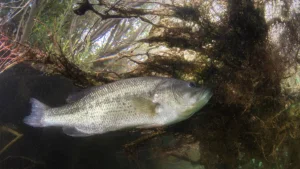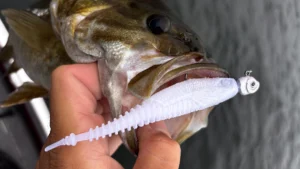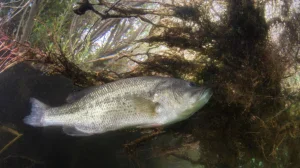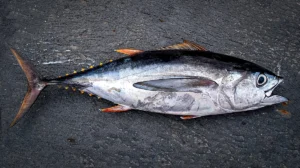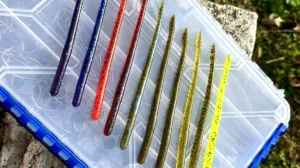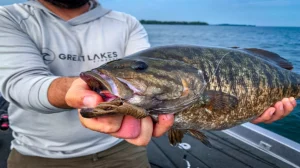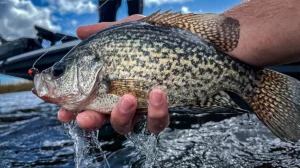All bass fishing hooksets are not created equally, or at least they shouldn’t be. There’s a wide range of ways to set the hook and the appropriate hookset for each situation varies not only based on technique but also line size and type.
Of course these are things you want to think through before you get a bite. Then instinct can take over in the heat of the moment and deliver the best suited hookset for a particular situation. So today we’re going to look at a few common hooksets, how they differ and which situations they should be used in.

Drop and pop ‘em
Not sure the proper vernacular for such a hookset, but anyone who has fished long at all knows this one. This is the one we all love and often deploy in the wrong situations as often as we do the right ones, because this is our natural reaction to feeling a bite. We drop our rod, reel up the slack a little and then hammer the fish.
This works really well for baits with big, bold, single hooks like football jigs and large Texas rigs, partly because there’s typically a good bit of line out when these bites come. More line means more stretch to account for. It’s also the appropriate hookset for Carolina rigs for the same reason, as long as the leader line and hook selection are strong enough to hold up to this kind of pressure.
You don’t, however, want to use this hookset with treble-hooked baits, light-wire hooks or light-line situations. So squarebills and drop shots are not good for this kind of hookset for a couple of examples. You’ll either break a fish off, bend a hook out or tear a big hole in a fish’s mouth on the hookset and lose them later in the fight as a result.
This is often a necessary hookset when using monofilament line in particular, because this line has a lot of stretch. For instance, say you’re throwing a Carolina rig on 20-pound test mono and you’ve made a really long cast. You’ll want to reel down and set the hook pretty hard in that situation.
But if you’re using light mono, a light-wire hook or treble hooks and the fish is close to you, you don’t want to use this hookset. There’s not a lot of line out so you don’t have to worry as much about the stretch and the hard hookset could prove too much for the light tackle. This leads us to our next hookset.

Lean into them
For this hookset, you don’t want to drop your rod at all. Instead, simply pull back and let your rod load up. This is the right hookset for a wide variety of techniques and situations. If you’re fishing a lipless crankbait or squarebill on any kind of line, this is the best hookset.
You’re actually letting the fish hook itself as it hits the bait and you just want to lean into the fish and let your rod bow up to ensure the light-wire treble hooks penetrate the fish. If you were to use a stronger hookset, you’d run the risk of bending or ripping your hooks through the meat or skin of the bass’s mouth.
This is also the best hookset for punching heavy mats and pitching sparse or submerged vegetation with a short line. The natural urge is to drop and pop them here like you would with a football jig, because the bites are often jarring and ferocious.
But if you have the right gear (consisting of a fairly long and strong rod with a parabolic bend, a stout reel with a strong drag and heavy braid or fluorocarbon), then leaning into the bass will actually get it headed out of the cover before it realizes what’s happening. If you drop and pop them, they’ll often spit the bait or get turned around a bit in that split second and you’ll miss the fish or have to pull it through more of the vegetation than necessary.

Reel set
This is the best hookset for drop shots, Neko rigs, wacky rigs and many other finesse techniques. In these situations, you reel while simultaneously leaning into the fish or pulling upward in the case of a vertical drop shot. This puts steady pressure on a fish as the rod bends, but doesn’t apply so much pressure that your line or hook fails.
It’s also important to have your spinning reel drag set properly in these situations so that it will slip. The drag will slip if the fish is large or headed in the other direction, while the reeling part of this hookset ensures that you’ll still apply pressure to the hook and set it well if the fish is swimming towards you.
This is also a great hookset for fishing a finesse swimbait on a jighead, there’s no need for a super strong hookset since the hook has a fairly light wire and is razor sharp. But the bass are sometimes cruising up behind this kind of bait before they hit it. Because they’re swimming towards you on the bite, if you simply lean into he fish without turning your reel handle, you may not hook the fish well. Leaning into the fish while reeling is the way to go so that you can make sure you miss fewer fish.

Final thoughts
There are, of course, a few other niche hooksets out there for very particular situations, but these three cover most of the bases. We didn’t talk about every technique each hookset works best with, so let’s lay out a few commonalties you can look for to help select the right hookset for whatever particular technique you’re curious about.
Nine times out of ten, if you’re fishing with heavy line and a big bold single hook, drop and pop them is the way to go. If you’re fishing with treble- hooked baits, you’ll almost always lean into them. Then with light tackle, a reel set is usually the way to go. Keep these simple rules in mind and you should be able to figure out the proper hookset for almost any bite a bass can throw at you.


